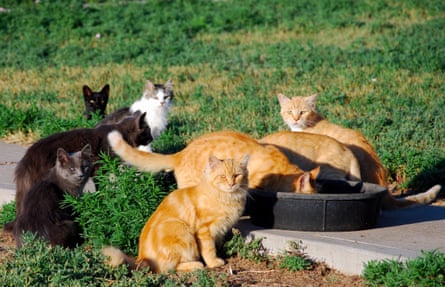After decades of mystery, new research has shed light on a question that has long stumped scientists and cat lovers alike – what exactly makes orange cats, well … orange?
Two studies published in Current Biology last week by separate teams at Stanford University and Japan’s Kyushu University at last provided some answers. Scientists have known for more than a century that orange cats inherit coloring differently from other mammals. Now – with help from hundreds of cat owners – researchers have identified the genetic mutation that gives orange cats their signature hue.
“From the time we started working on genetics of hair color, we have been fascinated to know what causes orange hair color in cats, and we know based on its inheritance that it must be different from what causes it in humans or dogs or mice or other animals,” said Greg Barsh, a professor of genetics at Stanford and the paper’s senior author. “What wasn’t known is what the mechanism was.”
To find out, the Stanford team began by collecting hundreds of cat DNA samples, visiting cat shows from California to Maryland and as far as Brazil. Researchers approached cat owners to ask whether they were willing to contribute and people were eager to participate, said Christopher Kaelin, a geneticist at Stanford and the study’s lead author.
“Cat owners and breeders are really open to genetic studies and contributing to genetic studies,” Kaelin said. “They’re very interested in their cats, and they’re very interested in talking about their cats and sending pictures, which is another big part of this study. All of that interest made it really easy to connect and collect samples.”
Collecting a sample involved sticking a cotton swab in a cat’s mouth and rubbing its cheeks to collect a small bit of DNA, Kaelin said. It’s much more challenging to collect a cheek swab from a cat than a dog, due to felines being particularly resistant to having things placed in their mouths. But researchers have learned specific techniques to distract the cats, including scratching their heads. Talking them through the process seems to help, he added.
“After doing several hundred cats, you learn what you can get away with and when you need to back off quickly,” Kaelin said.
As the study progressed, cat owners began reaching out in hopes of contributing, and mailed in brushes to the researchers. Several spay-and-neuter clinics contributed tissue samples from feral cat populations.
“Then in the lab, we could extract DNA from those samples and compare. We would then sequence portions of the genome and compare the sequences within those regions between orange and non-orange cats, looking for differences that might be the mutation that causes orange coat color,” Kaelin said.

Researchers collected about 200 samples for use in the study, and in total have collected more than 3,000 samples for their research. After sequencing the DNA, they compared the sequence of orange cats to non-orange cats, which helped them locate the precise alteration: a small piece of missing DNA responsible for the orange mutation, Barsh said, near the gene known as ARHGAP36. The mutation activates that gene, which gets specifically turned on in pigment cells where it is not normally active.
“It intersects with the same pathway that is responsible for red hair in humans, but it affects that pathway in a completely different way,” Barsh said. “That’s why the study is important. This is a pathway that is required for hormonal signaling in many different cell types in many different animals, including humans. We’ve learned this pathway can be modulated in a new way to, in this case, affect hair color. But we think that that applies broadly to all cells and all tissues.”
The fact that the samples were obtained in partnership with cat lovers in the community has allowed them to have greater engagement with the public, Barsh said: “Both of those examples with cat shows and working with spay-neuter clinics are examples of how partnering with the community helps science and science education. More broadly, it advances science and no cats are harmed.”
Kaelin has attended nearly 100 cat shows, he said, and presented research dozens of times so that cat owners have the opportunity to learn about what the team is doing. Feline color genetics are a useful scientific tool for discovery, and allow researchers to communicate scientific concepts to non-scientists. “It really bridges an important gap,” Kaelin said.

 2 hours ago
3
2 hours ago
3

















































